Welcome to Earth and Health Care Council
Welcome to Earth and Health Care Council
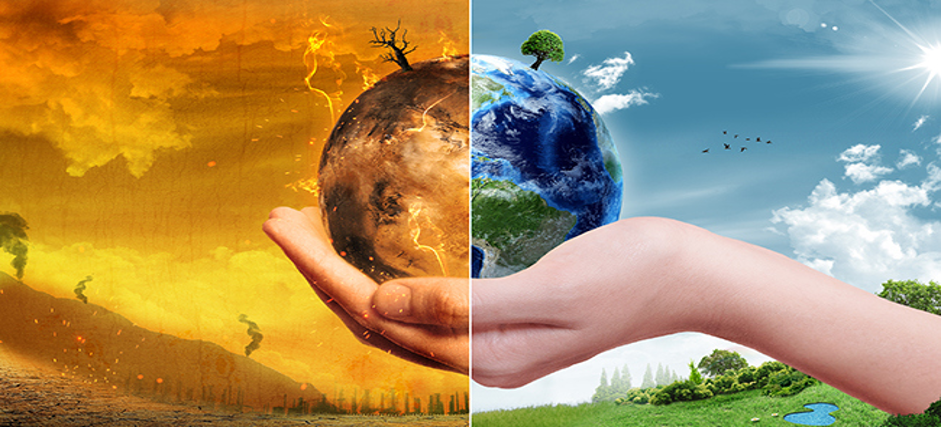
Climate change is one of the greatest challenges out time and its adverse impacts undermines the ability of all countries to achieve sustainable development. The plight of climate change began making a profound impact on the consciousness of humanity. Human activities are at the root of this phenomenon. The emergence of industrialization and urbanization has emitted Greenhouse Gases in abundance onto the air. Building and focusing on a sustainable development economy can help to reduce such Greenhouse Gas (GHG) emission that causes climatic change.
Impact of Climate Change:The polar ice caps melting, global sea levels rising and no country in the world is safe from the effect of climate change. The warmer climate spurs the evaporation of from land and sea and allows the atmosphere to hold more moisture, thus setting the stage for more extreme precipitation. The atmosphere’s water-holding capacity increases by about 4 percent for every one degree Fahrenheit (0.6 degree Celsius) rise in temperature. This effect is similar to the difference between a warm bathroom and a cold bathroom: the mirror fogs up more when the air warmer. In consequence, extreme precipitation is happened when a storm passes through a warmer atmosphere holding more water. In warmer months, it takes the form of torrential rainfalls, in winter, blizzards are more likely. This will precipitate wet places tend to get more wetter and dry places becomes more dry an barren land. Scholars from the Union of Concerned Scientists expects the recent trend of global warming will intensify more rainfall and more drought, if our carbon emissions continue unabated.
As of another study conducted by a group of scientists with the help of Satellite images of the planet’s poles, mountains, glaciers and numerical models revealed that our Earth has lost 28 trillion tones of ice in the last 30 years due to global warming on the impact of rising Greenhouse Gas (GHG) emissions which is continuously causing irreversible damage to the planet. The scientists warned and their analysis indicates that the sea level could rise considerably and reach a meter (3.2 feet) by the end of the current century. This rise could mainly cause of melting glaciers and ice sheets, sequel to which around one million people all over the world would be displaced their homes for every centimeter of sea-level rise. The melting of ice in these quantities would reduce the planet’s ability to reflect solar radiation back into space as white ice disappears, the dark sea or soil exposed beneath it absorbs more heat which further increases warming of the planet. The study further revealed that the cold fresh water is also pouring from the melting glaciers and ice sheets disrupting the biological health of Arctic and Antarctic waters and threatening the sources of fresh water on which local communities depend. Both sea and atmospheric temperature have risen triggering the catastrophic ice losses in the Himalayas is what we are witnessing right now.
Green House Gas (GHG) Effects: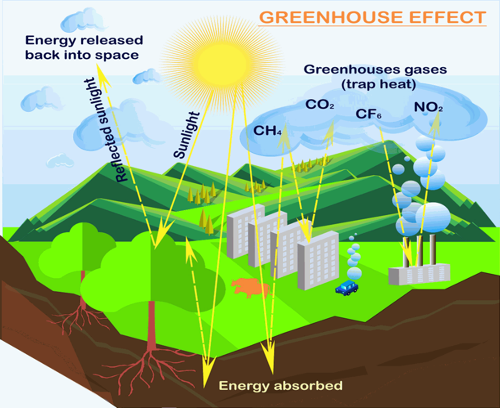
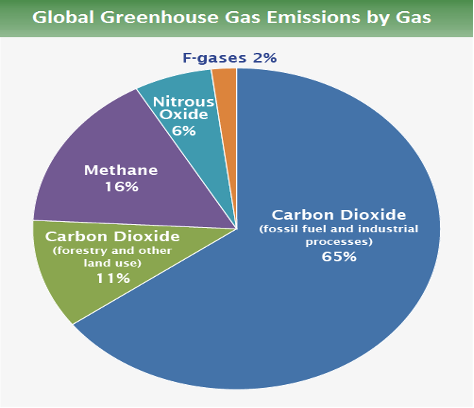
The emergent of large quantity of Green House Gases like Carbon-dioxide,, Methane, Nitrous Oxide, Flourished Gases are the contributers of global warming onto the earth. The emission of Flourished Gases has been mostly prevented by the efforts of UNO.
But the present scenario in the ratio of CO2 emission onto the environment is around 76 percentage of the total Green House Gases which is the main threat on global warming. It enters the atmosphere through burning fossil fuels (coal, natural gas, and oil), solid waste, trees and other biological materials, and also as a result of certain chemical reactions (e.g., manufacture of cement). Carbon dioxide is removed from the atmosphere (or "sequestered") when it is absorbed by plants as part of the biological carbon.
Methane is emitted during the production and transport of coal, natural gas, and oil. Methane emissions also result from livestock and other agricultural practices, land use and by the decay of organic waste in municipal solid waste landfills.
Nitrous oxide is emitted during agricultural, land use, industrial activities, combustion of fossil fuels and solid waste, as well as during treatment of wastewater.
Deforestation:Deforestation is a primary contributor to climate change. Cutting down large areas of forest and rainforest for resources such as wood, so that the land can be used as farmland reduces the amount of photosynthesis occurring, and so less carbon dioxide is removed from the atmosphere. According to the World Counts report every year from 2011-2015 about 20 million hectares of forest was cut down. Then things started to speed up. Since 2016, an average of 28 million hectares have been cut down every year. That’s one football field of forest lost every single second around the clock. The clearing of forests is a big contributor to global climate change. About 20 percent of the world's greenhouse gas emissions come from the clearing of tropical forests.
Unless we change the present system that rewards forest destruction, forest clearing will put another 200 billion tons of carbon into the atmosphere in coming decades. Smaller crops e.g. plants and agricultural crops also draw in carbon dioxide and release oxygen, however forests store up to 100 times more carbon than agricultural fields of the same area.
In order to cope up with the man-made emissions of Greenhouse Gases like Carbon dioxide, Methane and Nitrous oxide, the United Nation Organiza tion developed a police frame work of “2030 Agenda for Sustainable Development” which focused on one of the 17 goals of “Climate Action” and “the Paris Agreement on Climate Change” which strengthens the global response to the threat of climate change by keeping the global temperature rise well below 2 degrees Celsius above pre-industrial level or even below 1.5 degree Celsius on global surface temperature by this century.
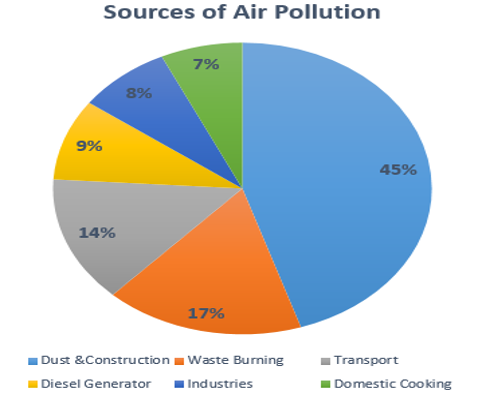
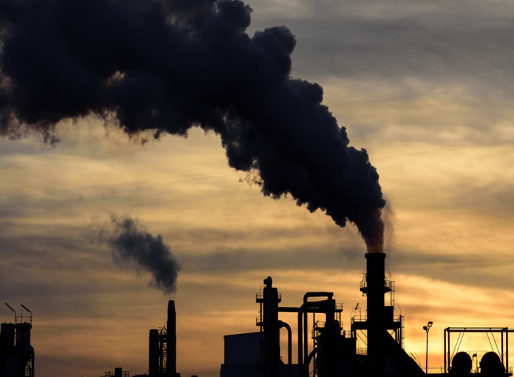
Apart from global warming, there is an another threat to healthy life due to lack of oxygen level in most of the cities due to industrialization and urbanization as most of the people in rural areas shifted to a hub of cities for accessing their livelihood which leads to congestion thereby to fulfill and secure a domicile place in urban and metropolitan cities, flat and apartment building construction system flourished and peoples spent their most span of life in the apartments where deficiency of oxygen automatically occurred as in general most of the family consists of 3 to 4 members which leads to deterioration to the health of urban people. In addition, proliferation of vehicles in urban areas releasing huge amount of toxic gases and CO2 that adds more deteriorating effects to the urban dwellers.
Also industries emits toxic and high CO2 that would prevail in the atmosphere of industrial hubs and the workers engaged in the industries would be highly affected over deficiency of oxygen that would lead to loss of targeted productivity.
Required Oxygen Level:A person living in the healthy surroundings with high oxygen level can perform an active life and his/her thinking and creativity power of brain would develop high that would lead to pleasure, healthy life and high productivity in industries. An air in the atmosphere contains 21 percentage of Oxygen is considered as good and healthy survival for human beings.
The minimum oxygen concentration in the air of atmosphere required for human breathing is 19.5 percentage and when the said level of oxygen drops below, that air is considered as oxygen deficient.
A large ratio of CO2 a person is releasing per day in terms of breathing and foods intake. The average adult, when resting, inhales and exhales about 7 or 8 liters of air per minute. That totals about 11,000 liters of air per day. Inhaled air is about 20-percent oxygen. Exhaled air is about 15-percent oxygen. Therefore, about 5-percent of breathed air is consumed in each breath. That air is also converted to carbon dioxide. So, human beings take in about 550 liters of pure oxygen per day. But that amount of required quantity of oxygen is almost unavailable to the residents of urban cities and main hub of commercial places.
The average human eats 2000 Calories (kilo Calories) of food a day. 100% of this food is processed, with all the carbon returning to the atmosphere. Our human would release carbon in other forms (feces, dried skin, shed hair, etc.) So there would be some solid waste as well as gas – but over long term, there would be some carbon dioxide released from that.
Impact of Oxygen Deficient:
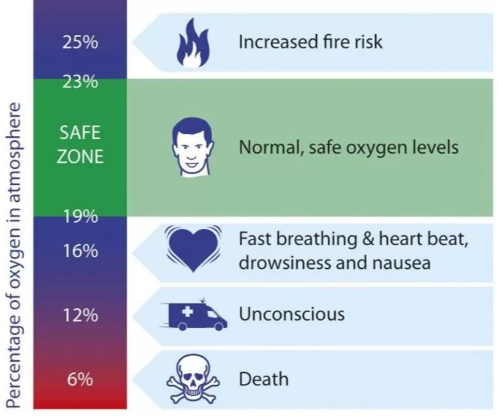
At concentration of 16 to 19.5%, human beings engaged in any form of exertion can rapidly become symptomatic as their tissues fail to obtain the oxygen necessary to function properly. Increased breathing rate, accelerated heartbeat and impaired thinking occurs more quickly in an oxygen deficient environment. At concentration of 12 to 16 percent oxygen, a person’s breathing and pulse rate increases and muscular coordination is slightly disturbed. People experience emotional upset, abnormal fatigue and disturbed respiration at 10 to 14 percent oxygen; and nausea, vomiting, collapse and loss of consciousness at 6 to 10 percent oxygen. Below 6 percent oxygen, people can develop convulsive movements and respiratory collapse; they can die.
In order to tackle the said issue, another goal of “Good health & well-being” as enshrined in the 17 goals of “2030 Agenda for sustainable development”.
In consonance with the same efforts of international agencies, our government has adopted various policies like promoting non-fossil fuels based energy, carbon sucking through enhancing additional forest and tree cover etc. for limiting carbon to reach the goals and the said stipulation.
Efforts & Plan of Earth & Health Care Council:The “Earth & Health Care Council” has determined the said two aspects in same perspectives for the welfare of peoples at large. In the same way of reducing the effects and neutralizing the CO2, and to be ensured a sufficient level of Oxygen available in the vicinity/premises of urban cities, industrial and commercial hubs, our organization “Earth & Health Care Council” also proud to be part of said drive and goals of United Nations thereby developed and implementing the project/program in the name of “Pure Oxygen Drive” by promoting and issuing most Carbon sucking and most Oxygen generating indoor plants like Bamboos, Money Plant, Snake Plant, Aloe Vera, Tulsi, Rubber plant, Areca palm etc., to every families persisting in urban cities, commercial hubs and to industries with free of cost and sapling most carbon sucking trees like Banyan, Neem, Peepal, Ashoka, Jamun, red sandal etc. in public places, which not only got neutralized the effects of Carbon-dioxide in the atmosphere, but also enhance an oxygen level in every houses and industries thereby generate a healthy lifestyle for human beings living in urban cities and enhance productivity to industries.



The aforesaid indoor plants and the red sandal are also very fruitful for absorbing and combats the radiation too as almost all the peoples are relying on wireless cell phones, Wi-Fi, and other tech devices which emits radiation has posed a serious threat to the health of peoples now a days.
Our Council has focused on a plan of action for People, Planet and Prosperity.
The said project be implemented in the following ways:
By effective implementation of this single project would reap three fruitful results of preventing climate change, enhance oxygen level and absorb radiation.
The Earth & Health Care Council has initiated the said “Pure Oxygen Drive” project by adopting two prong approach of making awareness and issuing indoor saplings free of cost, thereby Council has initiated publishing awareness videos through social media like Facebook Page and YouTube Channel in the name of “Earth & Health Care Council” and we requested your benign to subscribe the same page and channel. But we can achieve the plan of action in full-fledge only with the support of public at large and in consonance with the same effects, we the Earth & Health Care Council invites/welcomes you all to come forward to join an participate with us to fulfill the said goal effectively. Our Council is also expecting valuable feedback from your benign for our well-being. Please express your valuable support and feedback by sending messages to What’s app No.+91 7868887575 or scan the following What’s app QR code. For more details browse to www.ehcc.org.in